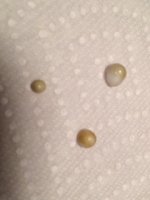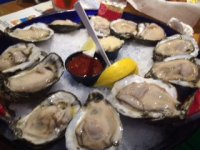Hoping for some help, as I know little about pearls. However I was so thrilled when I bit into an oyster in Naples, Florida and out came three pearls. The oysters were supposedly Golf Coast Oysters...that is all I know. I am going to try to post a picture of the pearls and also a picture of the plate of oysters. The largest pearl is about the size of a popcorn kernel. From the little research I have done, they appear to be non nacreous, but what does this mean? Thank you in advance for any info you can give me.
Cheers!
Cheers!


